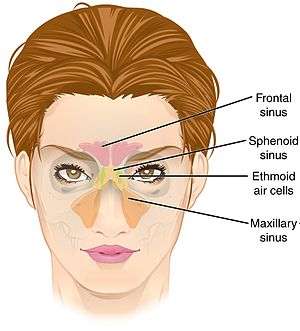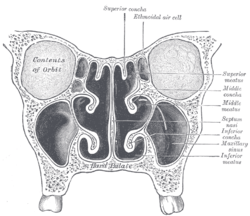Ethmoid sinus
The ethmoid sinuses or ethmoid air cells of the ethmoid bone are one of the four paired paranasal sinuses. The cells are variable in both size and number in the lateral mass of each of the ethmoid bones and cannot be palpated during an extraoral examination.[1] They are divided into anterior and posterior groups.[2] The ethmoid air cells are numerous thin-walled cavities situated in the ethmoidal labyrinth and completed by the frontal, maxilla, lacrimal, sphenoidal, and palatine bones. They lie between the upper parts of the nasal cavities and the orbits, and are separated from these cavities by thin bony lamellae.[3]
| Ethmoid sinus | |
|---|---|
 Frontal view of paranasal sinuses | |
 Coronal section of nasal cavities. | |
| Details | |
| Nerve | posterior ethmoidal nerve |
| Identifiers | |
| Latin | Cellulae ethmoidales, labyrinthi ethmoidales |
| MeSH | D005005 |
| TA | A06.1.03.005 |
| FMA | 84115 |
| Anatomical terms of bone | |
Groups of sinuses
The groups of the ethmoidal air cells drain into the nasal meatuses.[3]
- The posterior group the posterior ethmoidal sinus drains into the superior meatus above the middle nasal concha; sometimes one or more opens into the sphenoidal sinus.
- The anterior group the anterior ethmoidal sinus drains into the middle meatus of the nose by way of the infundibulum.
The two groups are divided by the basal lamella. This is one of the bony divisions of the ethmoid bone and is mostly contained inside the ethmoid labyrinth. Medially the lamella becomes the bony part of the middle concha.[4]
Development
The ethmoidal cells (sinuses) are not present at birth, however by 2 years of age they are recognisable through the use of Computerised Tomography (CT) scanning.[5]
Innervation
The ethmoidal air cells receive sensory fibers from the anterior and posterior ethmoidal nerves, and the orbital branches of the pterygopalatine ganglion, which carry the postganglionic parasympathetic nerve fibers for mucous secretion from the facial nerve.
Haller cell
Haller cells are infraorbital ethmoidal air cells lateral to the lamina papyracea. These may arise from the anterior or posterior ethmoidal sinuses.
Pathology
Acute ethmoiditis in childhood and ethmoidal carcinoma may spread superiorly causing meningitis and cerebrospinal fluid leakage or it may spread laterally into the orbit causing proptosis and diplopia.[6]
Additional images
- Ethmoid sinus. Ethmoidal air cells.Deep dissection. Superior view.
 Ethmoid sinus cancer that has spread to the lymph nodes
Ethmoid sinus cancer that has spread to the lymph nodes
References
This article incorporates text in the public domain from page 154 of the 20th edition of Gray's Anatomy (1918)
- Illustrated Anatomy of the Head and Neck, Fehrenbach and Herring, Elsevier, 2012, page 64
- St-Amant, Maxime. "Ethmoidal air cells | Radiology Reference Article | Radiopaedia.org". radiopaedia.org.
- Otorhinolaryngology, Head and Neck Surgery, Anniko, Springer, 2010, page 188
- Hechl, Peter S.; Setliff, Reuben C.; Tschabitscher, Manfred (1997). Endoscopic Anatomy of the Paranasal Sinuses. Springer Vienna. pp. 9–28. doi:10.1007/978-3-7091-6536-2_2. ISBN 978-3-7091-7345-9.
- Moore, K.L Et al(2014). Clinically Oriented Anatomy. Baltimore: Page960
- Human Anatomy, Jacobs, Elsevier, 2008, page 210
External links
- Anatomy figure: 33:04-07 at Human Anatomy Online, SUNY Downstate Medical Center
- Anatomy photo:33:st-0711 at the SUNY Downstate Medical Center